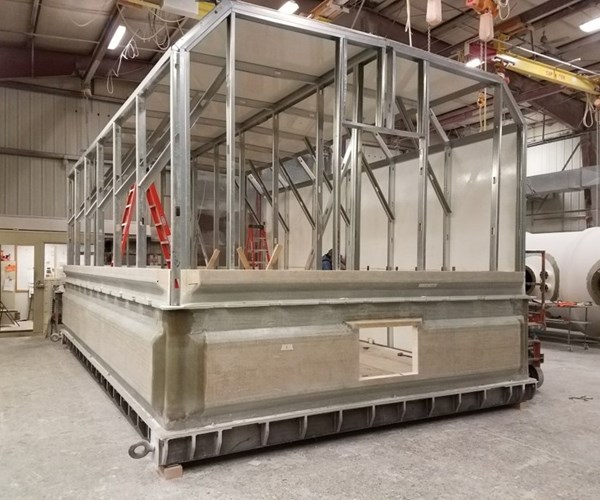Big composite container protects vital satellite
Before they experience the vibrations of launch and the rigors of the space environment, satellites first have to make it to the launch pad. Pagnotta Engineering Inc. (PEI, Exton, PA, US) was called upon by Orbital ATK (Dulles, VA, US) to design a shipping box to protect Orbital ATK’s GEOStar-3 geosynchronous satellite bus structure, during shipment.

This composite shipping container designed by PEI and built by Ershigs protects fragile satellites during shipment to launch locations.
Satellites are built to painstaking specifications using specialized materials, and represent huge investments. Before they experience the vibrations of launch and the rigors of the space environment, they first have to make it to the launch pad, intact. A company called Pagnotta Engineering Inc. (PEI, Exton, PA, US) was called upon by Orbital ATK (Dulles, VA, US) to design a massive shipping box to protect Orbital ATK’s GEOStar-3 geosynchronous satellite bus structure, during shipment from Dulles to launch locations such as French Guiana, for example.

This inside view of the container, with upper lid removed, shows the lower, immovable lid and the inner steel frame, with the support frame for the satellite.
The task was not trivial: the spacecraft can weigh up to 3,136 kg and has dimensions of 3.9m (max) by 2.1m x 2.3m. The container had to be able to fit through all Orbital ATK facility access doors, be strong and reliable with stable lifting provisions, be compatible with truck and rail logistics and most important, fit inside an Antonov 124-100 cargo aircraft. PEI developed a multi-material solution, including a welded steel base frame and a two-part composite lid, upper and lower, says PEI’s vice president John Callahan: “We decided on a two-section composite lid to reduce the overhead lifting requirements to clear the spacecraft, minimize the connections to auxiliary equipment and to simplify the interface to the base frame.” PEI developed the design in Pro/E CREO (Needham, MA, US) CAD software, and used NX/NASTRAN and FEMAP software from Siemens PLM Software Inc. (Plano, TX, US) for finite element analysis (FEA) to provide structural verification and that transport loading scenarios wouldn’t allow stresses above allowable limits.

The container was fabricated by Ershigs. The lower lid is shown here, with the upper lid panels being assembled with the help of a metal jig.
Composites were the right choice for the lid, beyond low weight, explains Callahan. They offered an airtight solution, with high thermal R-value and minimal joints, one that was weatherproof, strong and durable. Plus, the lids could be made on simple tooling to help keep costs low. The composite solution was a sandwich panel construction with skins of E-glass chopped strand mat, woven roving and knitted biaxial fabric, supplied by Owens Corning (Toledo, OH, US), Vectorply Composites (Phenix City, AL, US) and ValuTex Reinforcements (Washington Court House, OH, US), over a BALTEK (Sins, Switzerland) SB 50 balsa core. Resin was a Derakane Class 1 fire retardant vinyl ester from Ashland (Columbus, OH, US). The composite lids, upper and lower, were fabricated by Ershigs (Bellingham, WA, US).
The lower, immovable lid, at 7.7m long by 4.7m wide by 1.08m high, was connected directly to the base frame. The matching upper, 2.8m high lid attaches to the lower with multiple quick-release latches, and has casters mounted along its lower edge so it can be moved around when detached. A door in the upper lid allows access to the interior, and a lot of ancillary equipment, including an air conditioning unit, generator, electrical and nitrogen gas connections, gets attached to the metal base frame; multiple access panels and duct holes in the lower lid allow access for those systems to the interior. Inside, a large spacecraft turn-over and handling fixture and frame hold the satellite in place.

The shipping container can fit inside an Antonov transport aircraft.
So far, the shipping container has been used three times to successfully transport spacecraft. CW plans on a more detailed look at the design in an upcoming issue of CW magazine.
Related Content
Plant tour: Albany Engineered Composites, Rochester, N.H., U.S.
Efficient, high-quality, well-controlled composites manufacturing at volume is the mantra for this 3D weaving specialist.
Read MoreThe lessons behind OceanGate
Carbon fiber composites faced much criticism in the wake of the OceanGate submersible accident. CW’s publisher Jeff Sloan explains that it’s not that simple.
Read MoreSulapac introduces Sulapac Flow 1.7 to replace PLA, ABS and PP in FDM, FGF
Available as filament and granules for extrusion, new wood composite matches properties yet is compostable, eliminates microplastics and reduces carbon footprint.
Read MorePlant tour: Teijin Carbon America Inc., Greenwood, S.C., U.S.
In 2018, Teijin broke ground on a facility that is reportedly the largest capacity carbon fiber line currently in existence. The line has been fully functional for nearly two years and has plenty of room for expansion.
Read MoreRead Next
Developing bonded composite repair for ships, offshore units
Bureau Veritas and industry partners issue guidelines and pave the way for certification via StrengthBond Offshore project.
Read MoreAll-recycled, needle-punched nonwoven CFRP slashes carbon footprint of Formula 2 seat
Dallara and Tenowo collaborate to produce a race-ready Formula 2 seat using recycled carbon fiber, reducing CO2 emissions by 97.5% compared to virgin materials.
Read MorePlant tour: Daher Shap’in TechCenter and composites production plant, Saint-Aignan-de-Grandlieu, France
Co-located R&D and production advance OOA thermosets, thermoplastics, welding, recycling and digital technologies for faster processing and certification of lighter, more sustainable composites.
Read More






















